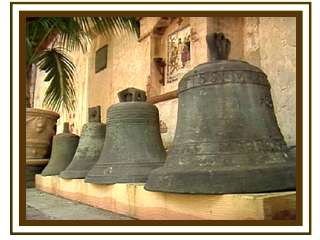


Mision San Carlos, Carmel
Golden State Gallery
Photo © Robert Holmes
|
Starting in 1769 with the founding of Mission San Diego de Alcala, the Fransiscan Fathers built 21 missions in California under Spanish colonial rule. The most famous is San Juan Capistrano, between Los Angeles and San Diego, a beautiful mission known
for its legend of the swallows, which return every year in March. Spain also built missions throughout Mexico and the Southwest, though few are as well known as the ones in California. The Missions were an essential part of the Spanish colonial structure. Their primary function was to Christianize the natives, to pacify them and educate them to become loyal Spanish subjects. Normally, a mission would support the development of a pueblo for Spaniards to settle in. A presidio (military garrison) would protect the missions and pueblos. Historically,
the missions were the most effective in contributing to the peaceful colonization of California. |

Reredos. Mission San Juan Bautista.
San Benito County, CA
Courtesy of Coolspots California
Link unavailable
| The Spaniards were also influential in destroying some of the pillars of native society. All of the European colonial nations, and indeed the United States in its westward expansion, have perpetuated horrible acts against the natives in the process of colonization. Spain, tragically, was no different. The priests' treatment of the natives was often quite harsh, due to the traditional European colonial attitude of cultural superiority. An equally important explanation for the Spaniards' actions in California is the fact that they enjoyed meager economic support from the colonial power. In fairness, it should be noted that throughout history a number of priests fundamentally rejected the dominant colonial attitudes toward the natives and acted as a voice of conscience in curbing colonial excesses. |

Mission Santa Barbara
Golden State Gallery
Photo © Robert Holmes
|
The majority of missions show a number of common architectural characteristics. One is the fountain at the center of the courtyard, which indicated the relative wealth of the mission. Another is the number of courtyards and gardens. Finally, there is the use of arches on many mission buildings. These all show the unmistakable influence of the Moslems on building and architecture in Spain following the expulsion of the Moors, and all were common traits in the architecture throughout the Islamic world. |

Altar-Mission Santa Barbara. Santa Barbara, CA
Courtesy of Coolspots California
inactive link
|
California Missions by Jeri Meier
The Spanish Missions of California
California Mission Studies Assn.![]()

Mission San Gabriel Arcangel Bells
San Gabriel, CA
©1997 by IVN Communications
|
Yosemite Friends Murals Brasil |
![]() Did
you enjoy yourself? Email me
Did
you enjoy yourself? Email me
|
Please visit my other web sites Voyage to Atlantis A Place in the Sun |
This page hosted by![]() Get
your own Free Home Page
Get
your own Free Home Page